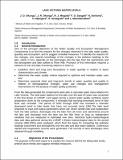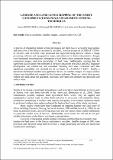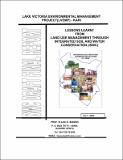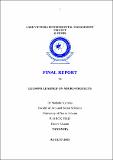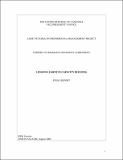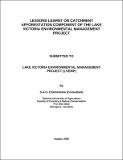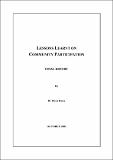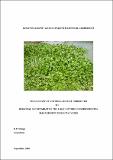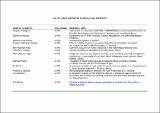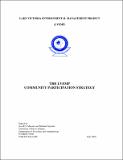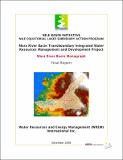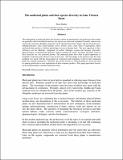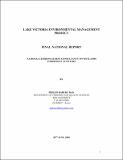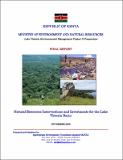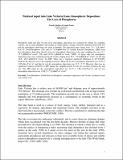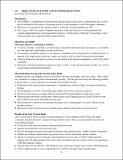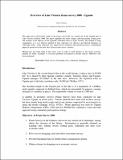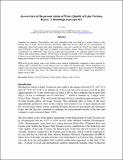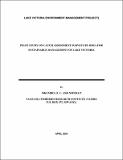Browsing Lake Victoria Environmental Management Project Phase I (LVEMP I) by Title
Now showing items 52-71 of 112
-
LAKE VICTORIA WATER LEVELS
(Lake Victoria Environmental Management Project (LVEMP), 2006)One of the principal objectives of the Water Quality and Ecosystem Management Components is to find the reasons for the changes observed in the lake water quality, quantity and ecosystem, and to suggest remedial measures. ... -
Land use and land cover mapping of the Simiyu catchment (Tanzania) using remote sensing techniques
(Lake Victoria Environmental Management Project (LVEMP), 2005)A process of integrating remote sensing techniques and field data to accurately map landuse and land cover of the Simiyu catchment is described. Satellite images of LANDSAT 7 ETM+ of 3/4/2001 and 12/5/2001 were processed ... -
Lesson learnt from land use management through Integrated Soil and Water Conservation (ISWC)
(Lake Victoria Environmental Management Project (LVEMP), 2005)River Nyando is one of seven major rivers within the Kenyan side of the Lake Victoria Drainage Basin. The other six rivers are Sio, Nzoia, Yala, Mara, Sondu-Miriu and Kuja- Migori. The Nyando and Nzoia rivers have been ... -
Lessons learned on micro-projects
(Lake Victoria Environmental Management Project (LVEMP), 2005)As part of the effort to take stock of its work in implementing micro projects, consider future direction and envisage action to be undertaken, LVEMP engaged a National Consultant from the Faculty of Arts and Social Sciences ... -
Lessons learnt in capacity building
(Lake Victoria Environmental Management Project (LVEMP), 2005)Lake Victoria and the overall Lake Basin (LB) is an ecoregion of local, national, regional and global importance. It supports the livelihoods of one third of the populations of the riparian countries and it can be a ... -
Lessons learnt on catchment afforestation component of the Lake Victoria environmental management project
(Lake Victoria Environmental Management Project (LVEMP), 2005)Lake Victoria is a shared water body by the three riparian countries of Kenya, Uganda and Tanzania. The lake covers a surface area of 68 800 km2 and catchment area of 184 000 km2 and supports approximately 30 million people. ... -
Lessons learnt on community participation final report
(Lake Victoria Environmental Management Project (LVEMP), 2005)The study was commissioned by Lake Victoria Environmental Management Project (LVEMP) and was conducted from June to July 2005. The main purpose of the study was to generate a comprehensive and analytical report on Lessons ... -
Lessons learnt: water hyacinyh control component
(Lake Victoria Environmental Management Project (LVEMP), 2005)The Water Hyacinth Control Component (WHCC) is one of the 10 components of LVEMP. The overrall goal of the components‟ focus is to control water hyacinth by reducing the weed to a manageable level. The approach chosen was ... -
LIST OF LVEMP SUPPORTED STUDIES AT MOI UNIVERSITY
(Lake Victoria Environmental Management Project (LVEMP), 2005) -
THE LVEMP COMMUNITY PARTICIPATION STRATEGY
(2004)Since its inception in 1997, the Lake Victoria Environmental Management Project (LVEMP) has made several efforts to integrate community participation across all project components. Success in implementation of community ... -
Mara River Basin Transboundary Integrated Water Resources Management and Development Project Mara River Basin Monograph
(2008)The Mara River Basin is shared between Kenya and Tanzania and covers seven districts: Nakuru, Bomet, Narok, Transmara, Serengeti, Tarime, and Musoma Rural. The river has a catchment area of about 13,750 km2, with an upper ... -
The medicinal plants and their species diversity in Lake Victoria Basin
(Lake Victoria Environmental Management Project (LVEMP), 2004)The management of medicinal plants has become a matter of international concern because these plants are generally wild in distribution and very few species are cultivated or planted. Presently, almost every Aayurvedic ... -
National lessons learnt consultancy on wetlands component activities
(Lake Victoria Environmental Management Project (LVEMP), 2005)This report presents a critical review of activities carried out by LVEMP Wetlands Component in the last seven years of the project with a view of coming up with lessons learnt form interventions implemented in the entire ... -
Natural occurrence and potential of pathogenic fungi for integrated management of water hyacinth, Eichhornia crassipes (Mart.) Solms-Laubach: Pontederiaceae, in Lake Victoria.
(School of Environmental Studies Moi University, 2002)These studies were conducted to determine the natural occurrence of pathogenic fungi assciated with water hyacinth in Lakes Victoria and Naivasha in Kenya. The aim was to investigate the potential of integrating some of ... -
Natural Resources Interventions and Investments for the Lake Victoria Basin
(Lake Victoria Environmental Management Project (LVEMP), 2006)The Lake Victoria Environmental Management Project Phase I The Lake Victoria Environmental Management Project Phase I (LVEMP I) was implemented in Kenya, Uganda and Tanzania since July 1997. The Project was executed by ... -
Nutrient input into Lake Victoria from Atmospheric Deposition: The Case of Phosphorus
(Lake Victoria Environmental Management Project (LVEMP), 2002)Phosphorus input into lake Victoria from atmospheric deposition was estimated by setting two sampling stations: one in rural (Itumbili) and another in urban (Igogo) settings. Nutrient estimation from both wet and dry ... -
OBJECTIVES OF LVEMP AND ITS IMPLEMENTATION
(Lake Victoria Environmental Management Project (LVEMP), 2002)The LVEMP is a comprehensive environmental regional program which aims at rehabilitating Lake Victoria and its catchment for the benefit of the people who live in the catchment as well as the global community. The ... -
Overview of Lake Victoria frame survey 2000 - Uganda
(Lake Victoria Environmental Management Project (LVEMP), 2002)This paper gives observations made on the frame survey that was carried out on the Uganda part of Lake Victoria in March 2000. The paper highlights the major changes affecting fishing, fishing gears and facilities in the ... -
An overview of the present status of Water Quality of Lake Victoria, Kenya: A limnological perspective
(Ministry of Environment and Natural Resources, LVEMP Water Quality Component, 2008)Sampling for nutrients, Chrolophyll-a and total suspended solids was done in 9 in-lake stations in the Kenyan part of Lake Victoria between December 2000 and October 2001. In-situ measurements of temperature, dissolved ... -
Pilot study on catch assessment surveys by BMUS for sustainable management of Lake Victoria
(Lake Victoria Environmental Management Project (LVEMP), 2004)The need to have a functional CAS system for Lake Victoria fisheries, to monitor changes and have reliable indices of relative abundance for the management of fisheries resources has been realised by all stakeholders ...

